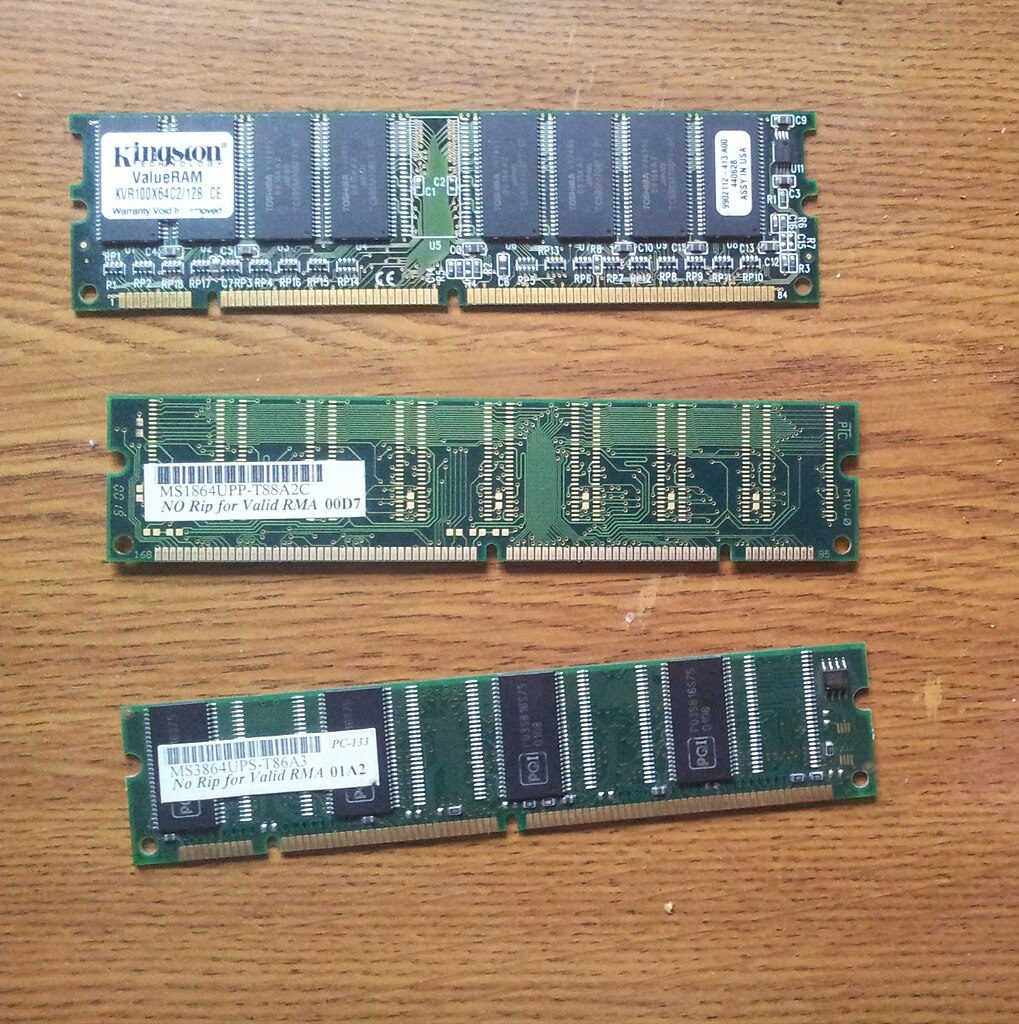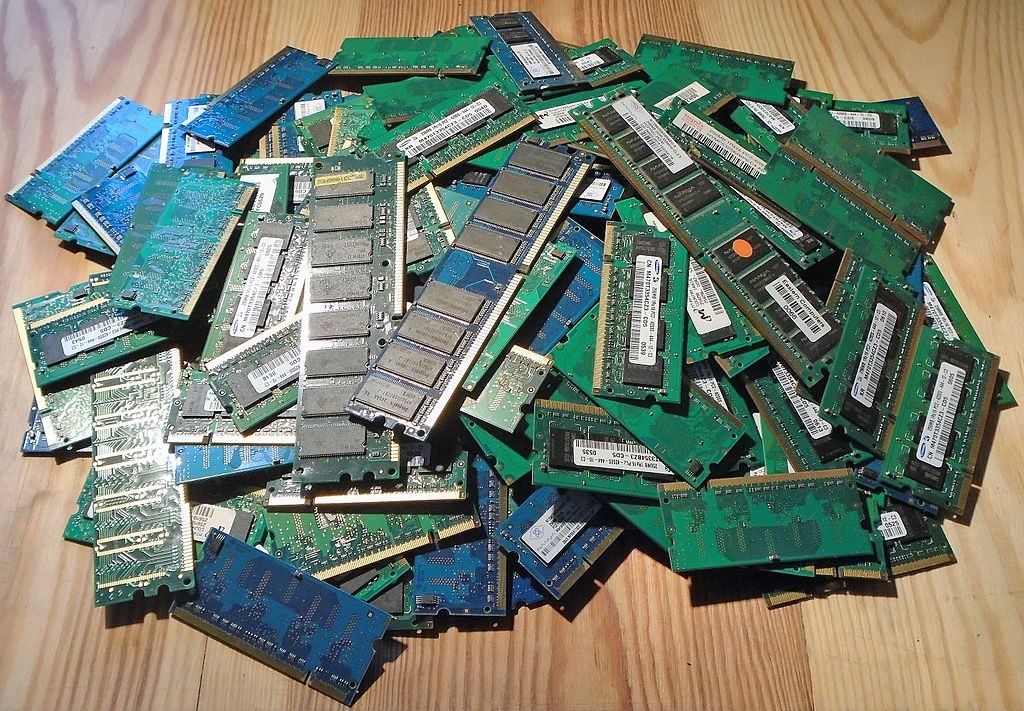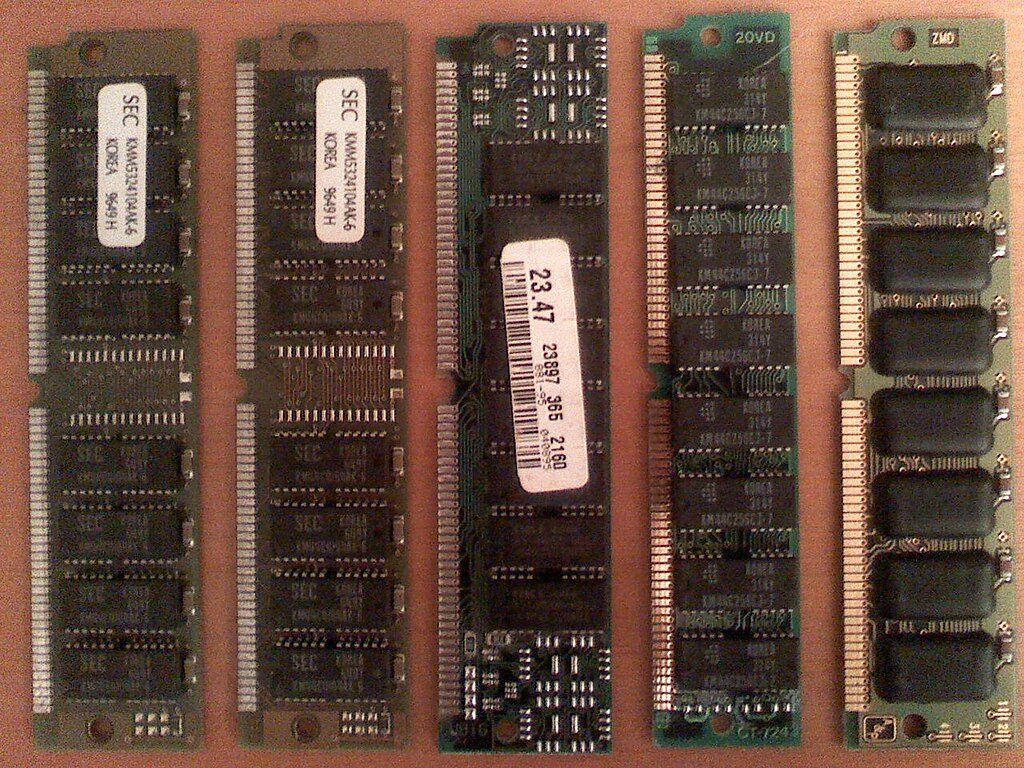RAM
If you’re just dipping your toes into PC building or you’re a pro tweaking your rig for that extra edge, we’ve got the scoop on everything Random Access Memory. Think of RAM as your computer’s short-term memory—it’s where all the action happens when you’re multitasking like a boss or blasting through levels in your favorite game. Without enough of it, your system feels like it’s running through molasses. Why care? Well, skimping on RAM is like trying to juggle with one hand tied behind your back—possible, but why make life harder? Fun fact: The first RAM was basically a bunch of magnetic rings in the 1950s, and now we’re cramming billions of bits into tiny sticks. Imagine upgrading from a filing cabinet to a supercomputer in your pocket—wild, right?

 – Credit: Wikimedia Commons
– Credit: Wikimedia CommonsContents
History
RAM’s journey is a tech saga straight out of a sci-fi novel—from clunky mechanical setups to lightning-fast chips that power AI and gaming beasts. Back in the day, early computers used stuff like relays or delay lines for memory, which were about as efficient as sending smoke signals. The real game-changer hit in the late 1940s with the Williams tube, a cathode-ray tube that stored data as charged spots—think of it as the OG random-access tech, powering the Manchester Baby in 1948, the first stored-program computer.
By the 1950s, magnetic-core memory took over, using tiny magnetized rings (one per bit!) and dominating until the 1970s. It was reliable but bulky—your modern smartphone has more power than those room-filling setups. Then came semiconductors: Bipolar memory in the ’60s, but MOS tech in 1964 by Fairchild cranked up speed and cut costs. Intel’s 1103 DRAM chip in 1970 was the first commercial hit, kickstarting the RAM revolution. Fast-forward to the ’90s with SDRAM, then DDR in the 2000s doubling data rates. Now in 2025, DDR5 is the king, with HBM for high-end AI and speeds soaring—revenues are projected to hit $136B next year, thanks to AI demands.
Pro tip: Moore’s Law kept shrinking things, but now we’re hitting walls with the “memory wall” bottleneck—CPUs are fast, but RAM access lags. Still, from 1KB chips to 128GB modules, it’s been a wild ride. Don’t bet against future breakthroughs like LtRAM for read-heavy AI tasks.

 – Credit: Wikimedia Commons
– Credit: Wikimedia CommonsTypes/Variations
RAM isn’t one-size-fits-all—it’s like picking coffee beans; different roasts for different brews. The big divide is between SRAM (Static RAM) and DRAM (Dynamic RAM). SRAM is speedy and stable, using flip-flops for bits, but it’s pricey and power-hungry—great for CPU caches but not main memory. DRAM, the workhorse in most PCs, uses capacitors that need refreshing but packs more density at lower cost—think billions of bits in a stick.
Variations? We’ve got generations: DDR4 is still hanging around for budget builds, but DDR5 is the 2025 standard, with faster speeds (up to 6400MT/s), higher capacities, and efficiency perks like on-die ECC for error correction—even in non-ECC kits. ECC RAM adds parity bits to fix errors, essential for servers but overkill for gamers. Then there’s SO-DIMM for laptops (smaller form), and high-bandwidth HBM for GPUs and AI.
Pros/cons: DDR5 shines in multitasking (up to 128GB per stick), but it’s pricier and needs compatible mobos. SRAM? Blazing fast but tiny capacities. Choose based on needs—gamers love 32GB DDR5 kits for future-proofing, while pros might grab 64GB+ for editing. Major brands: Crucial, Corsair, Kingston, G.Skill—stick to reputable ones to avoid fakes.
Quick comparison table:
| Type | Pros | Cons | Best For | Major Brands |
|---|---|---|---|---|
| DDR4 | Affordable, widely compatible | Slower than DDR5 | Budget gaming, older builds | Crucial, Corsair |
| DDR5 | Fast speeds, high capacity | Expensive, power-hungry | Modern gaming, AI | G.Skill, Kingston |
| ECC | Error correction, reliable | Costly, slower | Servers, workstations | Micron, Samsung |
| SRAM | Ultra-fast, no refresh | Expensive, low density | Caches, embedded systems | Various IC makers |
Humor break: Mixing DDR4 and DDR5? That’s like putting diesel in a gas car—boom, no boot!
How It Works
Pop the hood on RAM: It’s your PC’s scratchpad, holding data the CPU needs right now. At the core, RAM stores bits (0s and 1s) in cells—SRAM via transistors in a stable loop, DRAM with capacitors that leak charge and need refreshing every few milliseconds. Analogy: RAM’s like a chef’s countertop—quick access to ingredients (data) while cooking (processing). Long-term storage? That’s your SSD or HDD pantry.
Deeper: Data’s addressed via rows/columns; the CPU sends requests, RAM fetches in nanoseconds. Volatility means poof—data gone on power-off. Modern tricks like dual-channel (pairing sticks) double bandwidth, and XMP profiles overclock for boosts. For experts: DDR5’s double data rate means transfers on both clock edges, hitting 8400MT/s potentials. But watch the memory wall—CPU waits if RAM lags.

 – Credit: Wikimedia Commons
– Credit: Wikimedia CommonsCommon Pitfalls
RAM seems simple—plug and play?—but oh boy, the traps! Top mistake: Buying incompatible types, like DDR5 for a DDR4 mobo—your PC won’t post, and you’ll feel like a noob. Not seating sticks fully? No click means no boot, or weird crashes. Mixing speeds/brands? It works sometimes, but instability lurks—your system might throttle to the slowest stick.
Overheating from poor airflow, or forgetting to enable XMP in BIOS for rated speeds? Sluggish performance. Too little RAM (under 16GB in 2025)? Constant swapping to disk, hello slowdowns. Buying fakes from shady sites? Dead on arrival. Recent X buzz: Folks regretting 8GB laptops for modern tasks—upgrades or suffer. Humor: Installing RAM upside down? Congrats, you’ve invented a new paperweight!
Tips and Pointers
Picking RAM? Match your needs—8GB for basics, 16GB minimum for gaming, 32GB+ for creators (Steam says 32GB’s the new norm by late 2025). Installation: Ground yourself, align notches, push till click—dual-channel slots for best perf. Maintenance: Dust slots, run memtest for errors. Upgrades? Check mobo max, mix cautiously.
Budget? DDR4 kits save cash; eco? Low-power LPDDR for laptops. Troubleshooting: Crashes? Check temps, reseat sticks. Pro tip: Overclock DDR5 for free gains, but cool it—Buildzoid’s YouTube is gold. In 2025, eye 6000MT/s DDR5 for Ryzen/Intel balance.
Compatibility Considerations
RAM’s picky—wrong socket? No go. DDR generations aren’t interchangeable; check mobo specs (e.g., AM5 for DDR5 Ryzen). CPU matters: Intel/AMD have preferences, like Ryzen loving fast RAM for Infinity Fabric. Speeds? Mix at your peril—system downclocks.
Cooling: High-speed kits need airflow. GPUs? More RAM prevents bottlenecks in VRAM-heavy games. Avoid: Overfilling slots without voltage checks, or ignoring timings. Pro: Use PCPartPicker for foolproof matches.
Digging RAM? Check our pages on:
- Motherboards (RAM’s home base)
- CPUs (the brains needing fast access)
- Storage Drives (long-term vs. short-term memory)
- PC Building Guides (full assembly fun)
- Overclocking (push that RAM!)
- Cooling Systems (keep it chill)
References
- How to Choose RAM for a Gaming PC – Intel
- 10 Most Common Mistakes When Building Your Computer – PCGameHaven
- 31 Common PC Building Mistakes to Avoid – TechGuided
- Common Pitfalls to Avoid for First-Time PC Builders – ComputerCity
- r/buildapc on Reddit: Can you have too much RAM?
- How to Build a PC (2025): Hardware Suggestions, Instructions, and More – WIRED
- 8 Common PC Building Mistakes Beginners Make—and How to Avoid Them – MakeUseOf
- 5 Signs and Symptoms That Your RAM Is About to Fail – MakeUseOf
- How RAM Affects PC Performance & How to Free It up? – MiniTool
- What People Want – @peoplewant_ on X
- Robert – @block_robert on X
- LaurieWired – @lauriewired on X
- #TodayICT – @todayict_ on X
- Mohit Mishra – @chessMan786 on X
- G – @ggwhiting on X
- Sebastian Castellanos – @Sebasti66855537 on X
- Data Joe – @DataJoeG on X
- Beth Kindig – @Beth_Kindig on X
- Yuko Pangestu (Megamino) – @yukopangestu on X
- LaurieWired – @lauriewired on X
- TechRadar – @techradar on X
- LaurieWired – @lauriewired on X
- Church/Heliosares – @JamieChurch2 on X
- How RAM Works – HowStuffWorks
- What is Computer Memory? – Kingston
- Understanding RAM and DRAM Computer Memory Types – ATP
- What is Computer Memory and What are the Different Types? – TechTarget
- What is RAM? Understanding the Backbone of Fast Computing – Lexar
- Different Types of RAM Explained – Crucial
- Random Access Memory (RAM) – GeeksforGeeks
- What Are Gigabytes of RAM? A Complete Guide to Computer Memory – HP
- The Ultimate Guide to Computer RAM – Logical Increments
- Memory & Storage Timeline – Computer History
- What Is Computer and Laptop RAM and Why Does It Matter? – Intel
- What are the different types of computer memory? – Lenovo
- Memory vs Storage: Key Differences Explained – HP
- Explaining RAM – YouTube
- A laymans guide to RAM terminology – Reddit
- 9 Types of Computer Memory Defined – Enterprise Storage Forum
- What Does Computer Memory (RAM) Do? – Crucial
- The evolution of RAM – LinkedIn
- 14 Types of Computer Memory – Indeed
- How to Tell If Your RAM Is Going Bad – PC Tips
- Category:RAM – Wikimedia Commons
- File:RAM module.jpg – Wikimedia Commons
- File:SDRAM memory module.jpg – Wikimedia Commons
- File:Memory modules.jpg – Wikimedia Commons
- File:Old RAM.jpg – Wikimedia Commons
- Commons:Free media resources/Photography – Wikimedia Commons
- Creative Commons: Homepage
- File:Pile of Laptop & Desktop RAM Memory Modules.jpg – Wikimedia Commons
- File:RAM module SDRAM 1GiB.jpg – Wikimedia Commons
- A tip for finding public domain media on wikimedia – Reddit
- Random-access memory – Wikipedia
There you have it—your go-to RAM bible! Now snag some sticks and supercharge that setup. Remember, more RAM means less waiting—may your tabs be endless and your loads lightning-fast! 🚀
